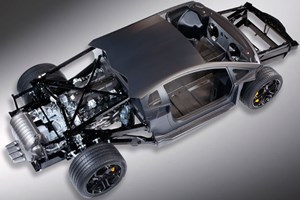Click Thumbnails to Enlarge

Tomorrow's world: lightweight carbon composites
By Jesse Crosse
Motor Industry
10 October 2011 09:09
Once all the dust settles on The Great Battery Farce (the idea that the world's ills will be taken care of by sticking a battery in everything that moves and charging it up) we may eventually face up to the fact that the best way to move something around more economically, is to move less of it.
That means making things lighter, a lot lighter. Car makers are working on it and manufacturers like Audi and Jaguar have already become masters in bringing aluminium to the mass production. But the biggest prize in the battle against weight, carbonfibre, has yet to make it to the mainstream.
Carbonfibre: the holy grail?
Carbonfibre is not just a costly material, it is fabulously expensive to turn it in to something you can use. As things stand, making family cars from it by the million is no more practical than asking a posse of Hollywood starlets to knit them from gold thread.
Single carbon fibres are a lot thinner than a human hair but wound together and woven into matting much like any other common-or-garden fabric, they become useful. Impregnated with resin the two become a carbonfibre composite component, fantastically strong and spectacularly light, but there's a downside. The process involved is almost as labour intensive as sowing a field of wheat by hand. It's just not practical for mass production.
Inside Lamborghini's composite lair
Lamborghini is owned by Audi but is also working with Boeing to seriously develop carbonfibre for production cars. The Lamborghini Aventador needs no further introduction on these pages but the way in which it has been made is fascinating. I?ll go further and wager that in just a few years, some of the technology that lurks behind it will be helping to cart the shopping back from Tesco in a million Audi A1 ancestors.
The Aventador consists of a carbonfibre tub front and rear-ended by aluminium spaceframes which support the suspension and powertrain. The tub is all carbonfibre but made by combining two distinctly different methods.
Prepreg carbonfibre: how it works
An odd name, short for 'pre-impregnated,' Prepreg is simply carbonfibre mat impregnated with resin. It's stored in a fridge like rolls of ready-made puff-pastry to stop it going off, then hand cut and laid into moulds. For strength, there can be no air bubbles so the whole lot is encased in a plastic bag and the air pumped out.
Then it's put in a huge oven called an autoclave and cooked under pressure to cure it. Prepreg is expensive but the best way to produce a shiny class-A finish, so only the top panels of the Aventador are made like this.
RTM-Lambo carbonfibre: Resin Transfer Moulding
In its raw form the bottom half of the tub looks unprepossessing, boxy and not unlike something you might sit in at Alton Towers. It's made using the resin transfer moulding process (RTM) where carbonfibre mat is cut and laid in a large mould and 'pre-formed,' then it's assembled into another giant mould together with the Prepreg components made earlier, and resin is injected under pressure. What comes out is the complete, beautiful, monocoque complete with moulded-in metal brackets on which to bolt the suspension and engine frames.
It's in the combining of separate elements to make a whole where RTM-Lambo differs from 'normal' RTM. It also differs in using cheaper carbonfibre moulds rather than huge, massively expensive steel tools of the sort generally used in car production.
The carbonfibre tooling is only good for around 500 shots before wearing out which is no problem in supercar volumes. For larger volumes, steel would be used. But there's a more recent development at Lamborghini that could form the basis of future mainstream cars.
Forged composites: the new composite tech borrowed from golf
Sometimes solutions to the trickiest problems come from the most unlikely direction and who'd have thought a supercar maker and a golf club manufacturer may have found the secret to mass-producing carbonfibre cars? This technology has been developed in conjunction with US golf giant Calloway, which has replaced titanium with lighter Forged Composite in its latest golf club head, so players can drive golf balls further.
Forged composite is a mixture of carbon strands around 2in long, mixed with resin. It can be quickly injection moulded in a similar way to plastic garden furniture, is a third of the weight of titanium, much stronger, a crucial 30% cheaper than the RTM-Lambo method and cures or sets in minutes instead of hours.
Forged composite has already been used in the Sesto Elemento concept car and on a trip around Sant'Agata I tripped over an experimental Aventador tub made from it. The process was patented only in 2010 and is too late for the Aventador, though next-generation Lamborghinis will use it.
But perhaps more relevant to most of us, it is easy to imagine the bodyshell of a future, super-lightweight, low emission baby Audi made from it, manufactured much like that garden furniture, but hopefully, more comfortable to sit in.




.jpg)




 4:31 PM
4:31 PM
 kapanturu
kapanturu










